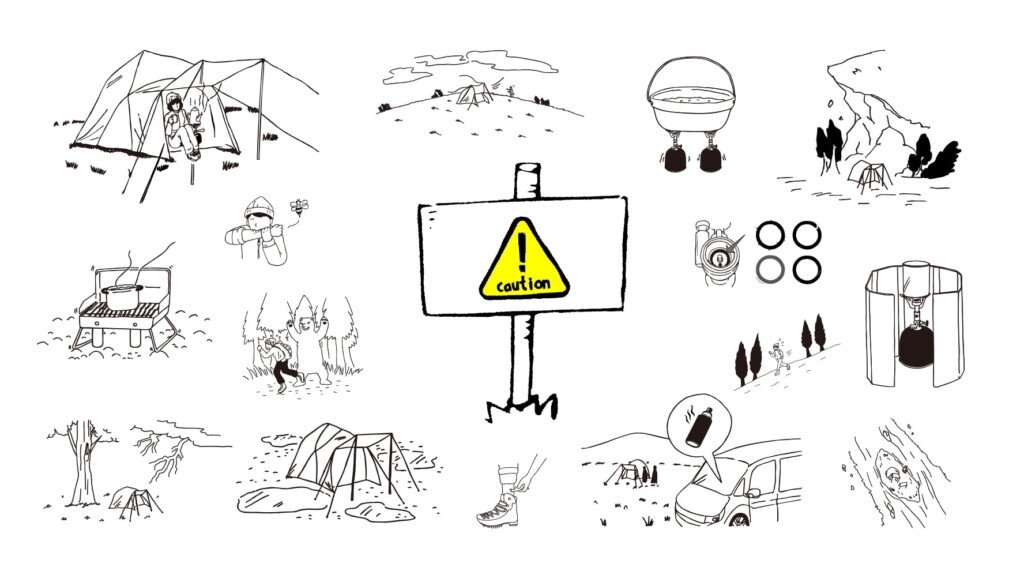
[Wait a minute for that action!] ] Summary of NG behaviors that you tend to do when climbing or camping
There are a lot of dangers outdoors. In such cases, just remember this
In outdoor activities such as mountain climbing and camping, there are surprisingly few places that are completely uninhabited. However, no matter how much human resources are involved or properly managed, as long as it is an activity in nature, humans cannot fully predict what will happen. Naturally, in nature, you must ultimately protect yourself.
This time, we have compiled a list of actions that are often used in the unlikely event of danger, but are not actually safe in order to enjoy outdoor activities such as mountain climbing, in order to safely enjoy the outdoors, such as mountain climbing.
Whether you've just started playing the outdoors or have been trying to pass by, thinking that you'll learn a lot someday, why not take this opportunity to check it out?
table of contents
- No action when using firearms
- No action to choose a tent or campsite
- No action in emergencies while acting
- When you get lost, you blindly descend the mountain
- When you run into a bear, turn your back and run at full speed.
- When bitten by a snake, it sucks out poison, cools it, or stops blood flow
- When stabbed by a wasp, it sucks out the poison in its mouth
- When he gets sucked up by a leech, he tries to force it to peel it off.
- Summary and supplements
No action when using firearms
Cooking with your favorite camping equipment and the spectacular dishes you can only make in the mountains are unique to the outdoors. However, convenient firearms such as gas stoves are one of the tools that can lead to serious accidents if used incorrectly. Use with great care so that you don't use it in the dangerous way as shown below just because it's convenient.
Use gas stoves in tents or indoors
 When using gas equipment such as gas stoves and lanterns, the most important thing to be careful about carbon monoxide poisoning . Not just outdoors, accidents occur all over Japan every year. Anyone using gas appliances should be aware of the risks of this carbon monoxide poisoning in any case.
When using gas equipment such as gas stoves and lanterns, the most important thing to be careful about carbon monoxide poisoning . Not just outdoors, accidents occur all over Japan every year. Anyone using gas appliances should be aware of the risks of this carbon monoxide poisoning in any case.
When gas equipment is used in poorly ventilated areas such as indoors or inside tents, incomplete combustion occurs due to a lack of oxygen, causing carbon monoxide to be generated. Carbon monoxide poisoning is caused by inhaling it.
Carbon monoxide is "tasteless and odorless," and it is said that it is very troublesome to notice because the symptoms of carbon monoxide poisoning are in the early stages, such as headaches, nausea, dizziness, poor concentration, vomiting, and drowsiness, which are generally similar to those of a cold (influenza). Depending on the concentration, the condition can progress to moderate or severe within a few minutes to a few minutes, and numbness in the arms and legs or loss of consciousness will prevent you from moving on your own, making it too late.
countermeasure
To avoid carbon monoxide poisoning, all you have to do is not to create a situation where carbon monoxide is produced. Just because it's cold outside, you should never use gas equipment in tents, cars, or other enclosed indoors. If you experience a situation that is likely to be "odd," and you feel like something is wrong, make sure to move to a place with fresh air immediately.
Use as a deteriorated O-ring
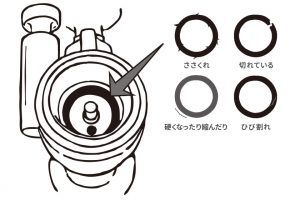 The connection between the gas cartridge and the burner is equipped with a rubber annular gasket called an "O-ring" to prevent gas leakage. Because it is made of rubber, it can be damaged, and even if it is not used, it will deteriorate over time.
The connection between the gas cartridge and the burner is equipped with a rubber annular gasket called an "O-ring" to prevent gas leakage. Because it is made of rubber, it can be damaged, and even if it is not used, it will deteriorate over time.
countermeasure
This is especially true at the beginning of the season, but when ignition, make sure that the O-ring is not shattered, broken, shriveled or cracked. Then try connecting the stove to the gas cartridge and check for leaks, damage, dirt, sand, etc. to the connection area.
It is recommended that the O-ring be replaced within 5-7 years. If the rubber deteriorates, not only will it show scratches such as cuts, shatters and cracks, but the rubber itself will harden or shrink overall. Never replace the O-rings yourself, but instead replace them in the way that the manufacturer or retailer instructed.
Place firearms in an unstable place
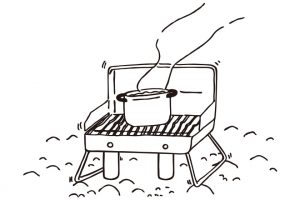 If you use a gas stove on sloped areas or unstable ground such as stones or gravel, the gas equipment may roll over and suddenly a large flame will burn, or the pot placed on top may spill and cause a large burn, which can be extremely dangerous.
If you use a gas stove on sloped areas or unstable ground such as stones or gravel, the gas equipment may roll over and suddenly a large flame will burn, or the pot placed on top may spill and cause a large burn, which can be extremely dangerous.
countermeasure
When using gas appliances, choose a flat, stable area.
Leave the gas cartridge near the heat source or in a hot place
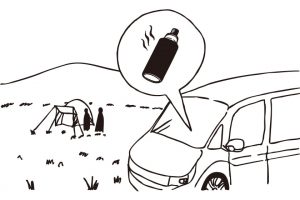 If the gas cartridge is heated abnormally, the pressure inside may rise rapidly and burst.
If the gas cartridge is heated abnormally, the pressure inside may rise rapidly and burst.
countermeasure
Be careful not to leave it in places where there is a possibility of high temperatures, such as on gas stoves and campfires while cooking, as well as on sandy beaches, riverbanks, paved roads under the scorching sun, or in a car exposed to direct sunlight.
Use two or more gas stoves side by side
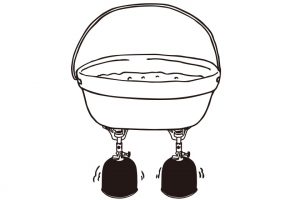 If you use multiple gas stoves side by side in a tight space or heat one pot with two gas stoves, the gas cartridge may overheat and burst due to heat coming from each other's stoves or radiant heat from the bottom of the pot.
If you use multiple gas stoves side by side in a tight space or heat one pot with two gas stoves, the gas cartridge may overheat and burst due to heat coming from each other's stoves or radiant heat from the bottom of the pot.
countermeasure
Always warm one pot with one gas stove, and when using multiple gas stoves, be sure to keep a distance. The two-burner type can be used safely because it has a structure in which the heat source, pot, and gas cartridge body are safely separated.
Surround the entire gas stove with a windshield or something similar
 When the wind is strong, use a windshield to keep out the wind. This is not a problem in itself, but if the entire area is surrounded too much, heat will accumulate inside the windshield, which may result in the gas cartridge being overheated and bursting.
When the wind is strong, use a windshield to keep out the wind. This is not a problem in itself, but if the entire area is surrounded too much, heat will accumulate inside the windshield, which may result in the gas cartridge being overheated and bursting.
countermeasure
How to use a windshield varies depending on the manufacturer, so be sure to check the precautions of each manufacturer when using a windshield.
No action to choose a tent or campsite
Although it is called a tent site, the types of danger vary depending on the topography, such as from the foot of the mountain, the middle side, on the ridge, or along rivers, streams, lakes, and seas. Furthermore, in a managed campsite, the features of facilities such as toilets, showers, cooking, and other fees vary. Below we will introduce some cases where you should never set up your tent in all cases, but you should be careful when setting up a tent in a specific location under certain conditions.
Set up tents on windsweats or on small hills
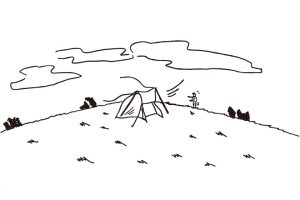 Setting up a tent in a spacious area, such as in the center of a wide field or on a small hill, is a pleasant experience, but caution is required from a safety standpoint. If you set up a tent that is easily affected by the wind, you can easily blow the entire tent even with a small, strong wind.
Setting up a tent in a spacious area, such as in the center of a wide field or on a small hill, is a pleasant experience, but caution is required from a safety standpoint. If you set up a tent that is easily affected by the wind, you can easily blow the entire tent even with a small, strong wind.
countermeasure
It is safer to set up the tent in a place where you are not easily affected by wind and rain, such as in a forest, but no matter where you place it, make sure to use pegs and ropes to protect yourself from windproof. If you're a campsite where you can also use cars parked upwind to protect yourself from wind.
Set up a tent in a poorly drained area
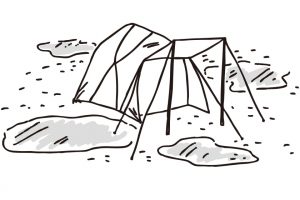 It suddenly started raining on the mountains. This often means that the amount of rain is greater than you imagined, and the ground gets flooded in no time. In such cases, if you set up your tent in a poorly drained area, such as a depression or ground that is difficult to absorb water, not only will it form puddles around it, which can be troublesome, but in the worst case scenario, the tent can become flooded.
It suddenly started raining on the mountains. This often means that the amount of rain is greater than you imagined, and the ground gets flooded in no time. In such cases, if you set up your tent in a poorly drained area, such as a depression or ground that is difficult to absorb water, not only will it form puddles around it, which can be troublesome, but in the worst case scenario, the tent can become flooded.
countermeasure
In addition to choosing a location that is as flat as possible, with no traces of water flowing, and with good drainage, it is also effective to set up a tarp on top of the tent and lay a ground sheet under the tent.
Set up tents near steep slopes or cliffs
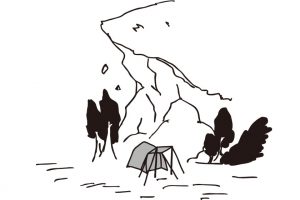 If it is a normal campsite or designated tent site, it is impossible for a tent site to be located near a dangerous cliff, but even if it does not seem to be a cliff, you should be careful if it is located near a steep slope. If something happens above the slope, such as after persistent bad weather and loosen the ground, there is a risk of rock falling.
If it is a normal campsite or designated tent site, it is impossible for a tent site to be located near a dangerous cliff, but even if it does not seem to be a cliff, you should be careful if it is located near a steep slope. If something happens above the slope, such as after persistent bad weather and loosen the ground, there is a risk of rock falling.
countermeasure
It is best to avoid being as close to the slope as possible, but even if you have to stick it on a location adjacent to the slope, try to keep it as far as possible.
Set up a tent on a large tree
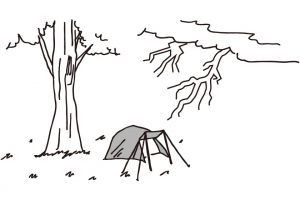 If a spacious field is sensitive to strong winds, then under the trees it is comfortable to have shade and is also comfortable, and it also prevents wind a little, so it's safer. It's not a mistake in a way, but there are things you need to be careful about. It's lightning.
If a spacious field is sensitive to strong winds, then under the trees it is comfortable to have shade and is also comfortable, and it also prevents wind a little, so it's safer. It's not a mistake in a way, but there are things you need to be careful about. It's lightning.
Lightning tends to hit high places, so larger trees have a higher chance of lightning strikes, and if lightning strikes on a tree next to the tent, there is a risk of lightning being hit by lightning.
countermeasure
If you set up a tent on a tree that is likely to be at high risk of lightning, camp away from the tree so that there is no need to worry about side-shots. In the first place, it is dangerous to be in a tent if lightning arrives. It is necessary to know the danger of lightning in advance and evacuate to a safe location with lightning protection equipment such as mountain huts as soon as possible. If there is no building such as a mountain hut, if possible, look for a tree that is at least 5m tall, look up at the top of the tree at a distance of 45 degrees or higher, and keep a low position, if possible, about 4m away from the tree.
Set up tents in riverbanks and Nakashu
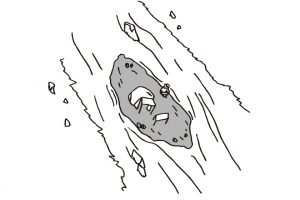 Every year, unfortunate accidents occur in which people who had just enjoyed camping were left behind by a sudden flood. If there is heavy rain upstream, the rising water level will rapidly increase downstream due to the rising water, and tents near the river will be easily swallowed.
Every year, unfortunate accidents occur in which people who had just enjoyed camping were left behind by a sudden flood. If there is heavy rain upstream, the rising water level will rapidly increase downstream due to the rising water, and tents near the river will be easily swallowed.
countermeasure
You should not set up tent sites on the riverbank or on Chushu. Even if the place is dry and dry at the time, the water level in the mountains can rise in the blink of an eye in no time when rain falls, so be sure to never set up tents on riverbanks or Nakashu.
No action in emergencies while acting
When you get lost, you blindly descend the mountain
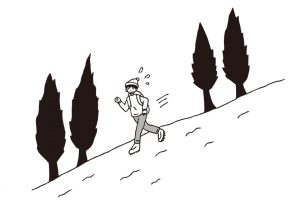 When climbing, even veterans often end up off the road due to carelessness. It would be great if you could quickly return to the right path, but in the worst case scenario, you might end up getting lost and not even knowing where you are from. In such cases, the most important thing to do is to go down without knowing your current location just because you want to descend the mountain quickly. If you head down the mountains to a place that seems easy to walk without thinking about anything, you will usually reach a stream. A waterfall awaits you, and you end up slipping and becoming unable to move, leading to more difficult situations.
When climbing, even veterans often end up off the road due to carelessness. It would be great if you could quickly return to the right path, but in the worst case scenario, you might end up getting lost and not even knowing where you are from. In such cases, the most important thing to do is to go down without knowing your current location just because you want to descend the mountain quickly. If you head down the mountains to a place that seems easy to walk without thinking about anything, you will usually reach a stream. A waterfall awaits you, and you end up slipping and becoming unable to move, leading to more difficult situations.
countermeasure
First, calm your mind and get a sense of where you are. If you know the way you came, turn back to the correct course. If you don't know where you are or where you came, instead of descending, you can move to a high place, such as a ridge, where you can see your current location. Even if you still don't know where you are and can't return to the mountain trail, don't panic and move around. Especially when the sun goes down and it gets dark, the chances of saving your energy and taking action will be higher if you bivouac and act calmly rather than just moving blindly.
When you run into a bear, turn your back and run at full speed.
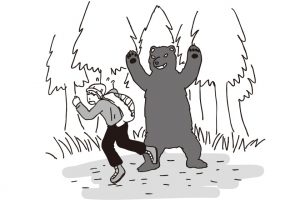 Bears are not creatures that actively attack people. However, bears suddenly encountering humans and are in a state of excitement, or in some kind of alertness, will attack you through your own defense instinct. Therefore, when you encounter a bear, you should not carelessly intimidate or make the bear get excited. One of the urgent actions you should not do when you run into a bear is to turn your back against it and run away. In the first place, it is almost impossible to escape with human athletic abilities, and if you drive at full speed along mountain paths while panicking, people will usually fall, and bears have a habit of chasing those who run away, making them even more dangerous.
Bears are not creatures that actively attack people. However, bears suddenly encountering humans and are in a state of excitement, or in some kind of alertness, will attack you through your own defense instinct. Therefore, when you encounter a bear, you should not carelessly intimidate or make the bear get excited. One of the urgent actions you should not do when you run into a bear is to turn your back against it and run away. In the first place, it is almost impossible to escape with human athletic abilities, and if you drive at full speed along mountain paths while panicking, people will usually fall, and bears have a habit of chasing those who run away, making them even more dangerous.
countermeasure
The best thing to do is to avoid seeing bears. Even if you find a bear, there's no need to worry as long as it's far apart. Slowly move away from the place so that there is no sound. If you are unlucky and have eyes on the bear, instantly stop moving in a direction facing the bear directly. Bears are very responsive to dynamic vision, especially lateral movements, so bears should not move horizontally, and just retreat quietly to gain distance. If you still get attacked, cover your neck with both hands and protect your abdomen by lying face down on the ground. Never resist being attacked at this time. When mountaineer Yamanoi Yasushi was attacked by a bear in Okutama in 2008, the bear nibed on his nose and refused to let go, but when he stopped resisting, he created a momentary gap and died, resulting in a lifetime. By the way, bear repelling sprays may also be effective, but this is not versatile either.
When bitten by a snake, it sucks out poison, cools it, or stops blood flow
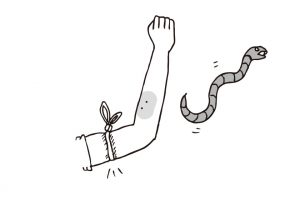 There are three types of venomous snakes that live in Japan: bear beetles, horned gazes, and hubu. With the exception of the hubs that live in Amami and the Okinawa Islands, belly bugs and mountain gasses will not attack unless you try them out, so be careful when walking through grass or slugs. However, if you still get bitten, the thing you shouldn't do (or rather, there's no point in doing it) is to force it to suck out with your mouth to suck out the poison, or to cool the affected area to reduce the swelling.
There are three types of venomous snakes that live in Japan: bear beetles, horned gazes, and hubu. With the exception of the hubs that live in Amami and the Okinawa Islands, belly bugs and mountain gasses will not attack unless you try them out, so be careful when walking through grass or slugs. However, if you still get bitten, the thing you shouldn't do (or rather, there's no point in doing it) is to force it to suck out with your mouth to suck out the poison, or to cool the affected area to reduce the swelling.
countermeasure
Hurry, run, drink alcohol, etc. to avoid increasing blood circulation more than necessary, and go to the hospital as soon as possible to receive treatment. It is said that there are not many people who die from viper poison, so even if you get bitten, you should never panic. Furthermore, it may not be possible to tell whether the snake is a poisonous snake based on bite marks alone, so remember as much as possible the snake has been bitten (take a photo if possible).
When stabbed by a wasp, it sucks out the poison in its mouth
 From my experience so far, hornets are probably the most troublesome creatures you encounter outdoors, such as their appearance frequency and difficulty in avoiding them. Around 20 deaths occur every year. If you accidentally approach the nest, it will attack you. As they have a habit of moving towards black things, be careful about what to wear when entering the mountains. If you are stabbed, be careful as if you stay there, your friends may be called and stabbed further. First, don't panic and gently leave the place. The thing you should not do when dealing with wounds is to try to suck out the venom with your mouth. It may be cool, but even if you suck it in your mouth, it won't be able to suck out the poison, and it is dangerous because it may be absorbed from the wounds inside your mouth.
From my experience so far, hornets are probably the most troublesome creatures you encounter outdoors, such as their appearance frequency and difficulty in avoiding them. Around 20 deaths occur every year. If you accidentally approach the nest, it will attack you. As they have a habit of moving towards black things, be careful about what to wear when entering the mountains. If you are stabbed, be careful as if you stay there, your friends may be called and stabbed further. First, don't panic and gently leave the place. The thing you should not do when dealing with wounds is to try to suck out the venom with your mouth. It may be cool, but even if you suck it in your mouth, it won't be able to suck out the poison, and it is dangerous because it may be absorbed from the wounds inside your mouth.
countermeasure
Rinse thoroughly with running water to the area that was stuck in the wasp. It then pressures the area around the wound and squeezes out the venom. Apply antihistamine or steroid ointment, cool it with ice packs, etc. and get treatment immediately at a medical institution. Especially if symptoms such as rash, nausea, or difficulty breathing (anaphylactic shock) occur within a few minutes of the moment you are stabbed, it can be life-threatening, so visit a medical institution as soon as possible.
When he gets sucked up by a leech, he tries to force it to peel it off.
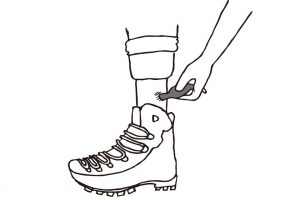 Yamabull is a terrestrial leech that is distributed throughout Japan except Hokkaido. I met Hill in Nishitanzawa and Iriomote Island. No matter how careful you wear clothes, it seems like it will come in, so be careful when walking around damp seasons or along streams. It enters your clothes and shoes, absorbs and continues to suck blood. Although there is no pain and no direct risk of life, the appearance of the leech itself and the visual discomfort, such as the bleeding continues even after it is released, is the best. If you are unlucky and bitten, you will want to pull it off as quickly as possible, and even if you force it, you may even pull it, but it may even expand the wound.
Yamabull is a terrestrial leech that is distributed throughout Japan except Hokkaido. I met Hill in Nishitanzawa and Iriomote Island. No matter how careful you wear clothes, it seems like it will come in, so be careful when walking around damp seasons or along streams. It enters your clothes and shoes, absorbs and continues to suck blood. Although there is no pain and no direct risk of life, the appearance of the leech itself and the visual discomfort, such as the bleeding continues even after it is released, is the best. If you are unlucky and bitten, you will want to pull it off as quickly as possible, and even if you force it, you may even pull it, but it may even expand the wound.
countermeasure
The leech will naturally separate if you roast it in a lighter or pour some rubbing alcohol, salt, vinegar, etc. After that, blood is squeezed out of the wound, and the anesthetic ingredients injected by Hill and the components that prevent blood clotting are expelled from the body, wash the wound with running water, then apply antihistamine ointment, and apply pressure and stop bleeding with a slurping or other device.
In any case, it's still troublesome if you're hooked by a leech, so it's important to make an effort to keep the leech at bay in the first place. Recently, commercially available leech avoidance sprays are available, so we recommend spraying them firmly when entering areas where leechs are located.
Summary and supplements
In mountain climbing and camping, there are many unexpected dangers that you wouldn't notice through your everyday sense, such as heat stroke, altitude sickness, snow blindness, fractures, mites, and plants. Furthermore, the measures introduced this time are merely part of the comprehensive measures, including precautions. To ensure sufficient knowledge and mentality, we recommend that you study with books that cover a comprehensive content. Why not take this opportunity to rethink your knowledge and preparation for safe mountain climbing?
Supervised by: Japan Gas and Oil Equipment Manufacturers Association
Check out the latest information to help you enjoy camping safely
CAMP HACK is an outdoor web magazine that delivers information for everyone interested in camping, with the catchphrase of "Getting excited like never before."
Japan's largest camping, outdoor, and news magazine | Camp Hack


 [Archive] 20 points you should know to use gas equipment more safely and conveniently
[Archive] 20 points you should know to use gas equipment more safely and conveniently Lighter, safer, smarter. A list of cooking tools to take to climb a tent and how to choose one (basic)
Lighter, safer, smarter. A list of cooking tools to take to climb a tent and how to choose one (basic)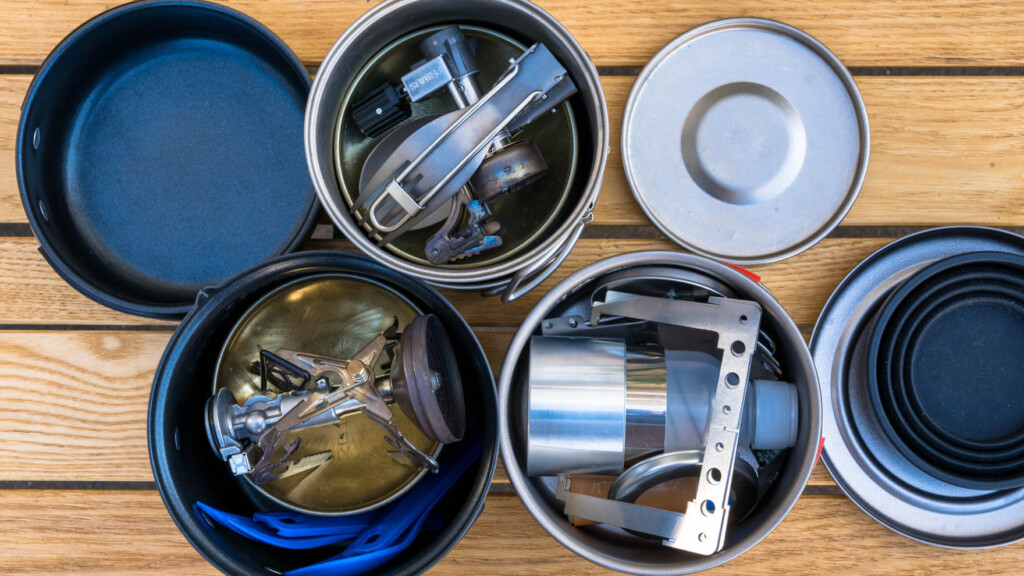 It's so much fun I forget about time. How to choose a stove, cooker, or cutlery to take to climb a tent [Practical Edition]
It's so much fun I forget about time. How to choose a stove, cooker, or cutlery to take to climb a tent [Practical Edition]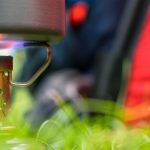 Directly taught by a mountain climbing guide! A story about gas stoves that outdoor enthusiasts should know - from mechanisms to how to choose, how to use, and maintenance -
Directly taught by a mountain climbing guide! A story about gas stoves that outdoor enthusiasts should know - from mechanisms to how to choose, how to use, and maintenance -